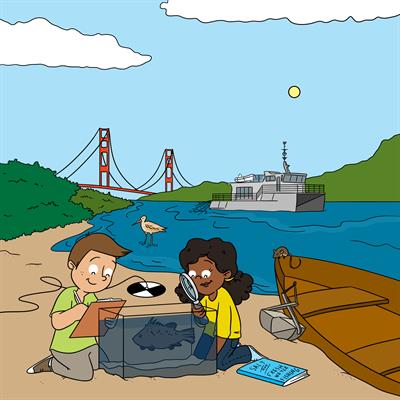
Where the river meets the ocean - Stories from San Francisco Estuary
Collection Editors
Peggy Lehman, Pedro Morais, Theodore Flynn, Frances WilkersonViews
623,339 viewsParticipating Sections
Submission Deadline
Closed
Articles

Biodiversity
31/05/2022
Using Conservation Planning to Create the Perfect...
Authors
Keiko Mertz, Aviv Karasov-Olson, Cliff Feldheim, John Eadie
Biodiversity
26/04/2022
Can Bacteria Save an Estuary’s Food Web?
Authors
Alice Tung, Peggy W. Lehman, John Durand
Biodiversity
08/04/2022
Untangling the Food Web of Suisun Marsh Using...
Authors
Caroline L. Newell, Teejay A. O’Rear, John R. Durand
Earth Sciences
31/03/2022
The Dangerous Disappearance of Delta Dirt
Authors
Dylan Stern, Dylan Chapple, Cory Copeland
Earth Sciences
29/03/2022
We Make the Delta, and the Delta Makes us
Authors
Alejo Kraus-Polk, Julian Fulton
Biodiversity
24/03/2022
Saving the Incredible Salt Marsh Harvest Mouse!
Authors
Katherine R. Smith, Melissa K. Riley, Laureen M...
Earth Sciences
17/03/2022
Fish Love Floods: Benefits of Floodplains in San...
Authors
Catarina Pien, Amanda Casby, Ted Sommer, Brian Schreier
Biodiversity
16/03/2022
Where the Young Fish Are: Monitoring for...
Authors
Lauren J. Damon, Steven B. Slater
Earth Sciences
15/03/2022
How Can We Use Computer Models to Learn About the...
Authors
Michael L. MacWilliams, Eli S. Ateljevich, Stephen G...
Biodiversity
15/03/2022
The Smallest Animals in the Water: Tiny but Mighty
Authors
Monika Winder, April Hennessy, Arthur Barros
Earth Sciences
14/03/2022
Keeping an Eye on Water Quality From the Sky
Authors
Francine H. Mejia, Christian E. Torgersen, Cédric G. Fichot
Biodiversity
11/03/2022
Murky Mysteries of Young Lamprey in the San...
Authors
Pascale Ava Lake Goertler, Kimberly Sheena Holley, Nicole...
Biodiversity
10/03/2022
Helping Nature in the San Francisco Estuary Cope...
Authors
Annika T. H. Keeley, Eva Bush, Dylan E. Chapple
Biodiversity
22/12/2021
Crime Scene San Francisco: Who Is Responsible for...
Authors
Mallory E. Bedwell, Craig Stuart, Melinda R. Baerwald
Biodiversity
18/11/2021
Aliens From an Underwater World
Authors
Pedro Morais, João Encarnação, Maria Alexandra Teodósio...
Biodiversity
02/11/2021
Small Shorebirds Feast On Green Slime To Fuel...
Authors
Laurie A. Hall, Susan E. W. De La Cruz, Isa Woo, Tomohiro...
Earth Sciences
25/10/2021
How Are Microplastics Invading the World?
Authors
Charlene Lujan-Vega, José Luis Ortega-Alfaro, Jennifer...
Biodiversity
18/10/2021
Diary of Wimpy Fish: How to Grow Up in a...
Authors
Amanda J. Finger, Daphne A. Gille, Nicole M. Kwan, Melinda...
Biodiversity
15/10/2021
Can Plants Be Engineers?
Authors
J. Louise Conrad
Biodiversity
07/10/2021
Estuaries, A Happy Place For Fish
Authors
Pedro Morais, Ester Dias
Biodiversity
07/10/2021
Living Fossils: Sturgeon of the San Francisco...
Authors
Page E. Vick, John T. Kelly
Biodiversity
23/09/2021
The Clever Strategies That Fishes Use to Survive...
Authors
Rachel A. Fichman, Adi Khen, Malte Willmes, Jonathon Kuntz...
Biodiversity
14/09/2021
Black Sea Jellyfish: Shocking Newcomers to Suisun...
Authors
Caroline L. Newell, John R. Durand, Mariah H. Meek, Peter B...
Biodiversity
13/09/2021
A Fish Story: Hot Water and Dangerous Behavior!
Authors
Brittany E. Davis, Ted Sommer, Nann A. Fangue, Anne E...
Biodiversity
10/09/2021
Delivering Food to Hungry Fish in the San...
Authors
Laura Twardochleb, Leela Dixit, Mallory Bedwell, Brittany...
Biodiversity
09/09/2021
If You Give a Clam an Estuary: The Story of...
Authors
Kelly H. Shrader, Emily L. Zierdt Smith, Francis Parchaso...
Biodiversity
07/09/2021
The Central Valley Salmonid Story: Six Million...
Authors
Hilary Glenn, Stacie Fejtek, Jacob Rennert
Biodiversity
03/09/2021
What Does Not Kill Can Weaken: How Herbicides...
Authors
Khiet Huynh, Tomofumi Kurobe, Marie Stillway, Chelsea Lam...
Biodiversity
26/08/2021
Are You a HAB Warrior?
Authors
Peggy W. Lehman, Tomofumi Kurobe, Timothy G. Otten, Melissa...
Biodiversity
25/08/2021
How Wetland Plants Deal With Stress
Authors
Taylor M. SloeyAbout this collection
What is an estuary? Where do they occur? How do they work? Who lives there? And why are estuaries important to our planet? This collection will answer all of these questions and more.Estuaries are places where fresh water from rivers moving downstream from the mountains mixes with salty water moving upstream from the ocean. Estuaries thus contain both fresh and salty water habitats (places) where many kinds of plants and animals can live and grow. San Francisco Estuary is the largest estuary on the West Coast of the United States and is home to millions of people, plants and animals. Our scientists have been studying all aspects of the San Francisco Estuary for nearly 50 years and we have 35 stories to tell about the people, plants, and animals in the estuary. We will tell you horror stories of how tiny poisonous plants and vampire fish kill other fish, and we have success stories of how conservation saves the lives of tiny mice in marshes and birds along the Pacific Flyway.
The Collection of stories is divided into six sections, so you can easily find the stories that interest you the most. The first section describes the many kinds of habitats in the estuary, including rivers, shallow bays, wetlands, and marshes, and what makes them a good home for plants, animals, and people. In the second section, the water quality scientists will describe how they use boats, special instruments, and new technology to determine whether the water is healthy for people, plants, and animals.
In the third and fourth sections we will tell stories about how plants and animals live in the estuary. Microbiologists will describe the tiny, microscopic plants and animals that live in the estuary, what makes them grow, how important they are as food for animals and why they are sometimes poisonous. Fish scientists will describe the many kinds of fish in the estuary and how we measure their growth, determine where they are, what they eat, and the ways they use both fresh and saltwater habitats to grow and raise their young. In the fifth section, scientists will discuss how invasions of plants and animals from outside of the estuary have changed habitats and the survival of native plants and animals. Lastly, we will share how scientists in the estuary are using new technologies and management actions to control invasions of unwanted plants and animals, increase the growth of native plants and animals, improve water quality, and restore habitats in the estuary.
Would you like to submit to this collection?
For researchers interested in submitting to this Collection, please consult our author guidelines and check that you have all the essentials included before submitting
Editorial Board
Collection Editors
Science Mentors

Alejandro Acevedo-Gutierrez

César Aguilar

Rita Araujo

Cristiana Ariotti

Usman Atique

Florence Awino

Melinda Baerwald

Chelsea Batavia

Ana Cristina Cardoso

J. Louise Conrad

Thomas Flynn

Gudrun Gegendorfer

Patricia Glibert

Joshua Israel

Gaurav Jain

David Kaplan

Annika Keeley

Yoed Kenett

Jessica Lee

Sarah Lesmeister

Melissa Mageroy

Alexandra Marques

Norma Martinez-Gomez

Briana Mittleman

Sarah Owens

Salza Palpurina

Shruti Parikh

Alexander Parker

M. Nils Peterson

Verena Puehringer-Sturmayr

Julia Rittenschober

Carlos Romão

Aditi Sengupta



